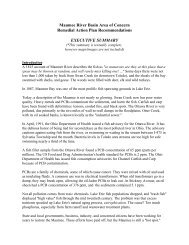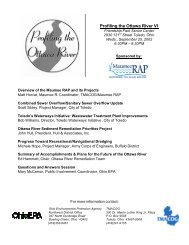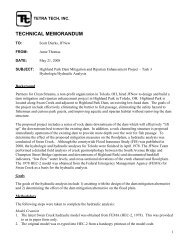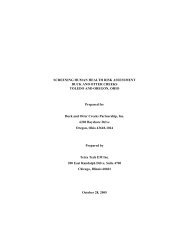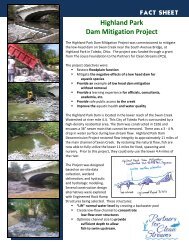Complete report - Partners for Clean Streams
Complete report - Partners for Clean Streams
Complete report - Partners for Clean Streams
You also want an ePaper? Increase the reach of your titles
YUMPU automatically turns print PDFs into web optimized ePapers that Google loves.
the surrounding areas, including the problem areas in Clay Township and the Village<br />
of Clay Center. Several (Woodland Estates, rest areas at the Ohio Turnpike, Genoa<br />
High School, and Guardian Industries) have been eliminated.<br />
Village of Holland Improvements<br />
1991-Present<br />
Description:<br />
In 1990, new sanitary sewers were installed and tapped into the Maumee River<br />
WWTP.<br />
Village of Swanton WWTP Improvement<br />
1991-Present<br />
Description:<br />
Swanton has a .92 mgd WWTP and a combined sewer system with a 2.5-MG<br />
retention lagoon with chlorination. Two storm sewer projects in the early 1990s<br />
eliminated some of the combined sewers and extra flow to the WWTP. However, the<br />
average flow rate of 257 gpd, showing a serious storm water infiltration problem that<br />
causes the WWTP to process a large quantity of extraneous water.<br />
Updating the Areawide Water Quality Management Plan (a.k.a. “208" Plan)<br />
1998 - Present<br />
Description:<br />
TMACOG is designated under Section 208 of the <strong>Clean</strong> Water Act to serve as the<br />
Areawide Water Quality Management Planning Agency <strong>for</strong> Erie, Lucas, Ottawa,<br />
Sandusky, and Wood Counties & Bed<strong>for</strong>d, Erie & White<strong>for</strong>d Townships of Monroe<br />
County. The “208” Areawide Water Quality Management Plan is TMACOG’s main<br />
water quality policy document. It states plans of local governments to meet the<br />
requirements of the <strong>Clean</strong> Water Act. Among the issues it covers are wastewater<br />
treatment, agricultural runoff, urban runoff, and septic systems. The entire “208” plan<br />
has undergone a comprehensive update since 1998.<br />
The largest part of the 208 Plan covers public wastewater treatment. Proper sewage<br />
treatment is a vital municipal service. It protects the environment and public health,<br />
and it makes economic development possible. The 208 Plan identifies what areas<br />
each wastewater treatment plant should plan on serving over the next 20 years. It<br />
helps local governments plan future infrastructure improvements; it prevents<br />
duplication of service, and identifies priority areas <strong>for</strong> sewer service. Ohio EPA uses<br />
Facility Planning Areas (FPA) boundaries in approval of sewers and wastewater<br />
treatment plants. All 62 Facility Planning Areas have been adopted by the TMACOG<br />
Board of Trustees, however the final approval is Certification by the Governor. The<br />
current FPA boundaries are posted on the TMACOG’s website (www.tmacog.org).<br />
TMACOG and Ohio EPA will hold a public meeting <strong>for</strong> review and input in early 2002.<br />
Maintaining the 208 Plan does not stop with Certification, there<strong>for</strong>e it is anticipate that<br />
TMACOG will be updating it annually.<br />
Lead Organization:<br />
TMACOG<br />
Reno Beach/Bono/Howard Farms Sewers<br />
Activities and Accomplishments<br />
in the Maumee Area of Concern<br />
200<br />
Issue 11: Wastewater<br />
Treatment Plants



